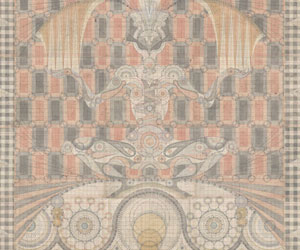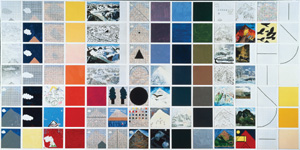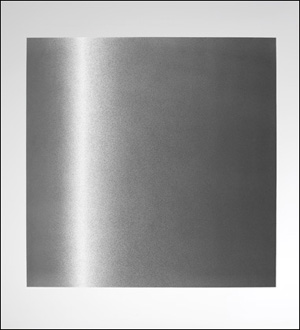Drawing Away from New York
John Haberin New York City
Louise Despont and Jennifer Bartlett
Drawing Dialogues: The Sol LeWitt Collection
One artist, still early in her career, draws away from New York to antique paper, ancient cultures, and an island in the Pacific. Another, in her seventies, returns to New York for care after years of drawing away to its more suburban and rural surroundings. Now they share space and a collaborator's music, which lends them each a healing stillness.
Louise Despont and Jennifer Bartlett bring new work to the Drawing Center and new narratives. The first sets her drawings in created architecture. The second uses pastels to describe a hospital interior and familiar architecture beyond. Following them, the Sol LeWitt collection presents Minimalism as focused but interdisciplinary, extending from graph paper to music. To quote Donald Judd, "The new three-dimensional work doesn't constitute a movement, style, or school." So how about a collection—or just friends? 
Chimes of freedom
Something stopped me in my tracks, and I looked everywhere to discover why. This being the Drawing Center, drawings lie visible through an opening at the center of the gallery. They almost fill sheets with their creamy colors. Still stranger patterns cover the front of what, it became clear, is an enclosure with green walls. Something else lies beyond, too, past another opening, but something plainer and sparer. The main walls to either side have sculpture in dark metal and wood, in the form of shelves, shields, and objects in motion.
But no, what held me was the sound of chimes, gongs, bells, and percussion. What looks like kinetic art is a sound machine, borrowing its rhythms from an Indonesian orchestra, or gamelan. And what look like off-kilter patterns on the first partition are something else again, too. Dowels in light wood cover it with their shapes and shadows, from the angled ceiling lights. As for what lies beyond, a second and larger enclosure, an oval with a plywood exterior, has still more drawings within. They owe their intricacy and color to graphite and colored pencil, on pages from old Portuguese ledger books.
Louise Despont has many ways to slow things down. Part is the slow unfolding of distinct shapes and media. Aaron Taylor Kuffner supplies the robotic gamelan, or "gamelatron," with the shields its chimes and the shelves its vibes. Despont herself supplies the nested architecture. Part, too, is the contrast between the denseness of the drawings and the near emptiness of the gallery—much as the sounds invite rather than penetrate contemplation. "Energy Scaffolds and Information Architecture" has just two sets of drawings, but no shortage of energy and information.
Energy is a theme throughout, cosmic and otherwise. Despont draws much of it, along with her designs and the music, from Bali, where she moved from New York. The drawings in the first enclosure lean to diamonds and to circles like phases of the moon. They extend to smaller shapes on the wood-tiled floor. Those in the second enclosure have more frequent curves and human forms. They also have a story to tell.
It involves, she explains, the passage from body, mind, and breath through death to the ultimate union of male and female. One may as well take her word for it, but no matter. The imagery and scale hold up on their own. While the sheets in the small, square room add up to eight drawings, those in the larger oval constitute a single mural, Pure Potential. They also invite one up close, to view the cells and handwriting of the antique ledger. They, too, tell a story familiar to Asian art, although not a legible one to western eyes.
One last story involves the passage between East and West. Both have a role in design, with its echoes of Tibetan or Indian art for Mrinalini Mukherjee, French curves, and Pattern and Decoration. Both also appear in the work's bilateral symmetry. It derives at once from formalism, Asian tradition, the ledger and its cells, the folds down the center of individual sheets, and the human body. Despont has moved from film and sculpture to architecture and drawing—and from the big city to a largely rural island. She says that she is comfortable only now, but she has not left any of it behind.
Art therapy
At last, evidence for art therapy. "Hospital" for Jennifer Bartlett could even share that honorific with its subject. Her twelve pastels at the Drawing Center show the world as she saw it during an extended stay at New York–Presbyterian Hospital. They serve as a record of confinement, release, and recovery, but also of her growth as an artist amid the fragilities of age. They have a luminous realism not often on view in her long and varied career. They also helped her in regaining strength and moving about.
 Bartlett bases them on photos from her stay, later cropped to a uniform square format—in the works on paper, thirty inches on a side. One does not often equate photography with physical therapy, but so it was. It became part of a patient's routine of getting out of bed and moving about. Anyone who knows her work, starting with the nearly a thousand plates of her Rhapsody from 1976, will assume that she did so diligently, if not compulsively. It became a good excuse to explore her environment, but also to look past "hospital time" to a world outside. The institution's Weill Cornell Medical Center has views of the Upper East Side, the East River, and the Queensboro Bridge. She duly noted confining walls, but also windows and the light.
Bartlett bases them on photos from her stay, later cropped to a uniform square format—in the works on paper, thirty inches on a side. One does not often equate photography with physical therapy, but so it was. It became part of a patient's routine of getting out of bed and moving about. Anyone who knows her work, starting with the nearly a thousand plates of her Rhapsody from 1976, will assume that she did so diligently, if not compulsively. It became a good excuse to explore her environment, but also to look past "hospital time" to a world outside. The institution's Weill Cornell Medical Center has views of the Upper East Side, the East River, and the Queensboro Bridge. She duly noted confining walls, but also windows and the light.
She could imagine herself moving past the windows and into the light. Bartlett has been working in pastel from at least In the Garden in 1980, but not often with the same strictness of form and observation. "Hospital" starts with two views of nothing but walls, coming together as if to bar exit. Another sheet has a puddle of light past long shadows, beneath a glimpse of more uniform whiteness in the air and on the ground. The final sheets take the windows face on, and the city takes on a firmer reality, anchored by the bridge. The pastels become more structured, with a window frame as solid and vertical as supporting beams.
They also serve as a departure. For starters, the series has a plain focus and direction. Contrast the twelve sheets with Rhapsody—or the nearly four hundred components of Recitative in 2011. Rhapsody positively defies direction with its catalog of painterly styles, from abstraction to child's play, like the ultimate in languages of art. It also explodes those languages, just as formalism was then giving way to Postmodernism, and it still exploded across four walls as part of the Broida collection in 2006. For once, one did not have to feel embarrassed for MoMA's atrium. Bartlett captured the four seasons in 1990, but she also layered her realism with other marks of free play and the great outdoors, from a patterned blanket to dominoes and playing cards.
"Hospital" marks a return to the city, for an artist who has long been moving away to that actual or mythical garden. Now seventy-five, she grew up near the ocean, and a Bartlett retrospective originated on Long Island at the Parrish Art Museum. And here she is, as William Carlos Williams has it, "by the road to the contagious hospital." Of course, Williams was a doctor in New Jersey, and the poem, "Spring and All," is set "under the surge of the blue / mottled clouds driven from the / northeast—a cold wind." This, though, is the city where I myself grew up, and it looks pretty darn good. (Cue "The 59th Street Bridge Song," and please do not insist that I adopt the landmark's renaming for Mayor Koch.)
For all that, Bartlett still defies a narrative. The angled walls could stand instead for motion, while the outside views, including a tower still under construction, could stand for longings she cannot yet fulfill. Scenes are devoid of people, inside and out, with the window frames like bars. And they end with alternative modes of realism after all, in scattered licks of red and white for traffic on the FDR Drive. Together, they could stand for contemplation rather than progression, backed by the chimes in the Center's front room. That stillness could prove the ultimate in art therapy, much as a younger artist, Hayley Barker, speaks of "vintage self-yhlp"—and put a difficult episode for Bartlett herself to rest.
Just friends
Donald Judd was his usual stubborn self in defining Minimalism by what it was not, in "Specific Objects," but understandably. Otherness was in the air in 1965, what with Marxism, Existentialism, and soon enough Postmodernism. Besides, style was so superficial for anything as serious as art back then, while movements and schools were so confining and so yesterday. Someone like Judd would not dream of joining a club that would accept him as a member, and neither would Sol LeWitt. And yet LeWitt was happily working away on his art, looking about for common ground, and building a collection. With roughly one hundred selections, the Center sees him as "Drawing Dialogues."
The show does not include Judd or his former school friend and studio mate, Frank Stella, but it ould well have, for it is all about friendships and dialogues. It weaves in plenty by LeWitt himself, as jumping-off points for both. Anyone who knows LeWitt from his busy wall drawings will know him as a compulsive collaborator. And sure enough, his collection runs to some four thousand works by some seven hundred and fifty artists. That does not even count the assistants who executed the graphite scribbles that dissolve into glowing horizontal bars facing the entrance. The result might please even Judd, by presenting an art not of rules, but of possibilities.
Naturally much dates from just twenty years, beginning in the mid-1960s. Naturally, too, most is on paper, given the Center's purpose and the show's title, but not all. It starts right out with Ruth Vollmer's Pseudosphere, or dowels generated by revolving a curve about a line, and models by Jackie Ferrrara of what might become still grander Slatted Pyramids. Giulio Paolini builds a landscape from gold nails, as Sotto le Stele (or "under the stars").  The back room has more overtly sculptural or conceptual work, including wall text by Lawrence Weiner, a circular wall incision by William Anastasi, a white square of fluorescent light by Dan Flavin, and a still frailer square of black yarn by Fred Sandback. One can see them as alternative modes of physicality, invisibility, clarity, and defacement.
The back room has more overtly sculptural or conceptual work, including wall text by Lawrence Weiner, a circular wall incision by William Anastasi, a white square of fluorescent light by Dan Flavin, and a still frailer square of black yarn by Fred Sandback. One can see them as alternative modes of physicality, invisibility, clarity, and defacement.
Downstairs the show turns to LeWitt the hoarder, and friendships become explicit. He saves working drawings, but also postcards—from On Kawara with when and where the Japanese artist got up and from Carl Andre "with love." These, Andre writes of LeWitt and his works, "are the bones of our dreams." Meanwhile the main gallery focuses on works on paper as ends in themselves. As curators, Claire Gilman and Béatrice Gross group them according to concept, medium, and technique. This being Minimalism, those amount to very much the same thing.
After the physical models come works on graph paper, with Mel Bochner and Eva Hesse, and disruptions of the grid by Adrian Piper and Alighiero Boetti. Line becomes looser, as with Ree Morton's "delight in foul odors" and Mario Merz, for The Space of This Growth Pours into the Infinite Space. Then it tightens again to play off against tangential geometries, as with Pat Steir and Robert Mangold, or against the physical presence of loose or folded paper, as for Jo Baer and Dorothea Rockburne. Next it argues for collaboration as interdisciplinary, with sheet music by Philip Glass and Steve Reich, dance by Lucinda Childs, and reflections on architecture by Jan Dibbets and Sylvia Plimack Mangold. Finally comes a glance at a world long before Minimalism, with a battle of "idealism vs. realism" by Honoré Daumier, a gridded motion study by Eadweard Muybridge, and a sketch after Piero della Francesca by LeWitt himself. With each step a formula, a plot, or a plan takes on another dimension.
The show has a welcome diversity, including women—and Ferrara has additional wall paintings downstairs in the "Lab Corridor" (the bathrooms, to you) as a Drawing Center commission. Yet no one will mistake it for a fashionable grab-bag of global movements, styles, or schools. When MoMA hauls out its art of the 1960s, it attempts just such a broadening, but then it is left with nothing to hang it on but ten years, one to a room. It becomes as embarrassing as too much classic rock and vintage clothing. Say what you will about LeWitt's collection, it is not quaint. It is the progressive defining of an artist, an era, a circle of friends, and a sensibility.

Louise Despont and Jennifer Bartlett ran at the Drawing Center through March 20, 2016, "Drawing Dialogues" through June 12. Jackie Ferrrara ran there through March 17, 2017, art of the 1960s at The Museum of Modern Art through March 12. Related reviews look at the art of Sol LeWitt and at Bartlett's "Rhapsody" and "Recitative" along with her 2013 retrospective.




